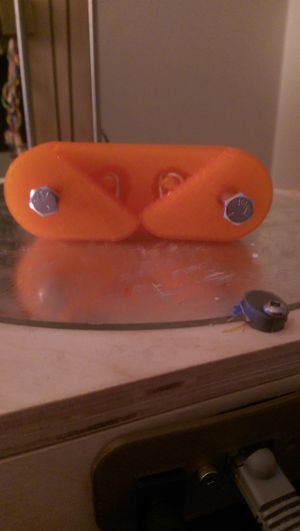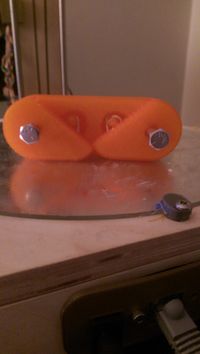
Cam Cleat[edit | edit source]
Project developed by Thomas Korejsza (talk) 16:55, 7 December 2015 (PST)
Abstract[edit | edit source]
- This OSAT design is an economical alternative for a cam cleat. Basic cam cleat designs are utilized for many functions. They are typically used as a quick release and locking mechanism for ropes and chords. These devices are usually found on sailing vessels as a method organize and hold lines. Additionally, with few modifications of this design, one being a pulley, a mechanical ascender should be able to be printed.
- Cam cleats typically use leaf springs to provide their action, however, this is a prototype using rubber bands. The loads for this prototype need not be large to confirm how the rest of the design responds to an action.
- Having the option to 3D print a cam cleat at sea is attractive as it can save frustration in the event of a failure. During light to medium wind conditions, a 3D printed cam cleat should be sufficient until a replacement can be obtained.
- Picture of completed print using

Bill of Materials[edit | edit source]
- Materials needed for fabrication of device and alternative materials if they are not available, prices/sources of non-printable parts
- Plastic - roughly 66 grams of PLA which equates to $1.52 at $22.98 pr 1Kg.
- Rubber bands- large assortated package at $1.68
*ONLY NEED TWO BANDS!
- Two 3mm bolts & Two 3mm Nuts ~ $0.98
- Link to Thingiverse with scad and stl files.
[|https://www.thingiverse.com/thing:1183173]]
Tools needed[edit | edit source]
- MOST Delta RepRap or similar RepRap 3-D printer
- C-clamps for setting nut into base plate.
Thomas Korejsza (talk) 16:55, 7 December 2015 (PST)
Skills and knowledge needed[edit | edit source]
- Novice skill with OpenScad is required for the modeling.
- Knowledge of a cam cleat was required.
Technical Specifications and Assembly Instructions[edit | edit source]
- Directions for assembly
- Download the .stl and/or .scad files.
- Print both base plate and cleats.
- Insert nuts into bottom of the base plate. C-clamps help secure them to their location.
- Located on the base plate and cleat are pegs, use a rubber band between these two pegs to provide the spring action. (Note. you may want to double over the rubber band to create more tension.
- Place bolt through cleat clamp and screw into nut.
- print time estimate- 3 hours
- Assembly time estimate 5-10 minutes
- Including drawings or pictures of the device at stage of assembly at minimum. (Upload)
Common Problems and Solutions[edit | edit source]
- A common issue with this design is that the rubber bands providing the action may slip off when relaxed. This can be solved two ways, either provide a lip for them to stay on or use an exceptionally tight rubber band.
- Also, an improvement to this design would be a better stopping mechanism so the cam does not reverse on it self when relaxed.
- Both issues can potentially be solved when using a leaf spring instead of rubber bands.
Cost savings[edit | edit source]
- Total cost using sum from BOM - $2.55
- Commercial equivalent [Harken Cam Cleat] $31.50
- $ savings = $28.55
- % savings = %90